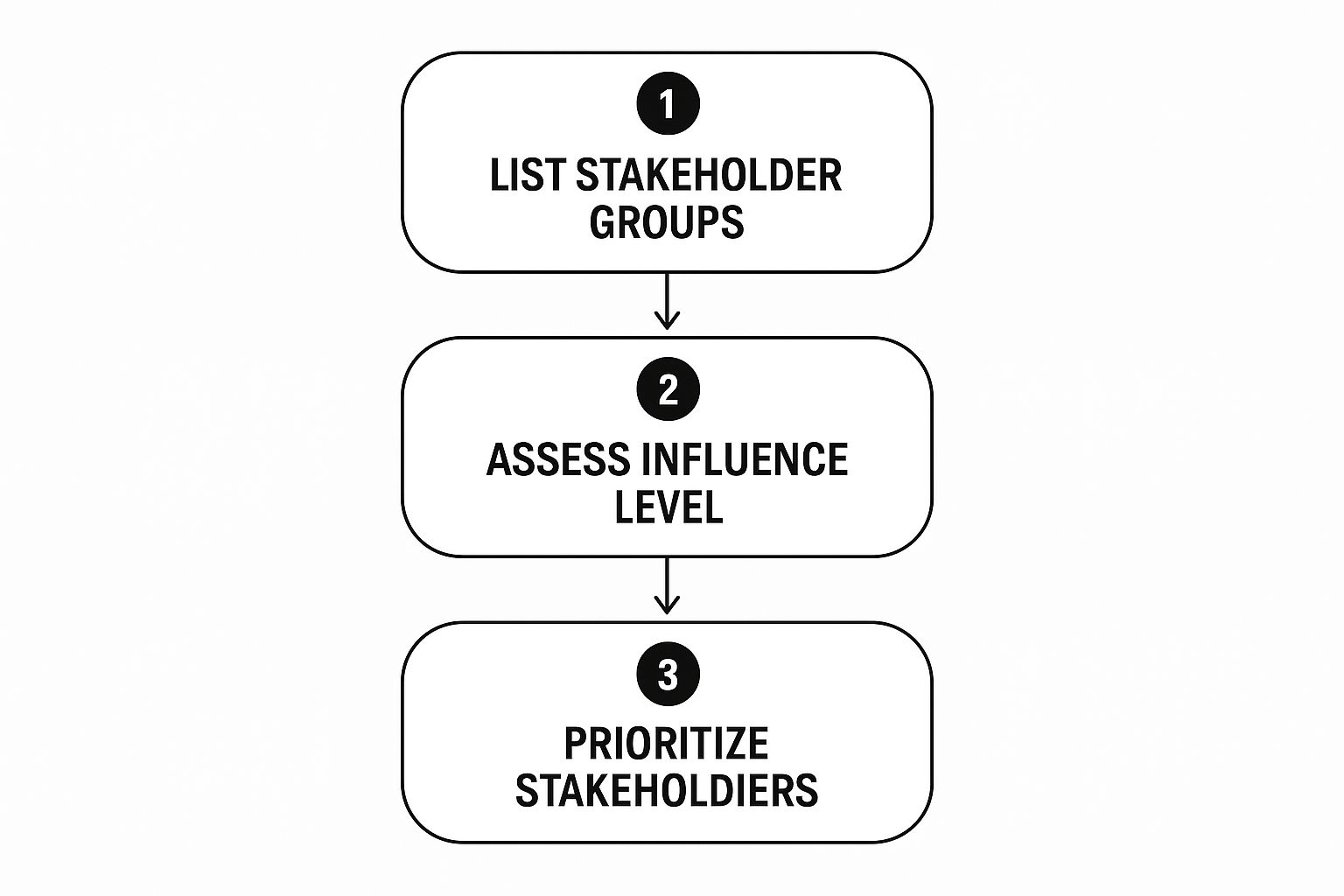Let’s get one thing straight: a stakeholder communication plan isn’t just another formal document to check off your list. Think of it as a strategic roadmap for keeping every key person and group looped in, engaged, and on your side from kickoff to launch. It’s less of a bureaucratic formality and more like an insurance policy against the misunderstandings and misalignment that can sink a project.
Why a Communication Plan Is Your Project’s Secret Weapon

I know what you’re thinking. Another plan? My to-do list is already a mile long. But trust me, a well-thought-out stakeholder communication plan is anything but administrative fluff. It’s a genuine strategic advantage that shifts your entire approach from reactive damage control to proactive relationship management.
By clearly defining who gets what information and when, you sidestep the most common project killers: scope creep, blown budgets, and missed deadlines, all often rooted in mismatched expectations. This is the framework that keeps your executive sponsor and your end-user team on the same page, even if their updates look completely different.
The Strategic Value of a Clear Plan
A solid plan is about so much more than scheduling a few emails. It’s about building trust and securing the buy-in you absolutely need to succeed. The research backs this up time and again, showing a direct line between stakeholder engagement and project success. In fact, one study found that 75% of successful projects achieved high levels of stakeholder involvement right from the start. That’s a powerful number that shows how a formal plan directly fuels positive outcomes. If you want to dig deeper, there’s some great recent industry analysis on how communication secures buy-in.
The real goal isn’t just to inform your stakeholders—it’s to involve them. A great plan turns passive observers into active champions by delivering information that’s relevant, timely, and easy to digest.
To give you a clear map of what goes into one of these plans, I’ve broken down the core components we’re about to cover. Each piece builds on the last, creating a powerful, comprehensive strategy that actually works.
Core Components of a Stakeholder Communication Plan
This table outlines the foundational pillars of any effective communication plan. Getting these four stages right is the key to turning your strategy into a well-oiled machine.
| Component | Objective | Key Activity |
|---|---|---|
| Audience Mapping | To identify and prioritize all stakeholders. | Creating a Power/Interest Grid. |
| Message Crafting | To tailor information for each group. | Defining specific goals and key takeaways. |
| Cadence & Channels | To establish a reliable update schedule. | Selecting appropriate channels (e.g., email, meetings). |
| Automation | To streamline execution and save time. | Integrating tools like HubSpot for Jira. |
Each of these components is a critical step in building a plan that not only looks good on paper but also delivers real-world results by keeping everyone aligned and supportive.
How to Map Your Stakeholder Landscape
Before you even think about writing an email or scheduling a meeting, your communication plan needs a map. A solid, visual map of every single person who has a stake in your project. Without it, you’re essentially shouting into the wind and just hoping the right people hear you.
Start with a simple brain dump. For now, forget about who’s most important and just list every individual, team, or group that could possibly be affected by or have influence over your project.
This first list will feel messy, and that’s okay. It should include everyone from the executive sponsor signing the checks to the end-user team whose day-to-day work is about to change. Don’t forget to loop in adjacent departments like legal, finance, or marketing, who might have an indirect but crucial interest. The goal here is a complete census of your project’s ecosystem.
This flow gives you a high-level picture of how to go from a jumbled list to a prioritized action plan.

Remember, just identifying your stakeholders is only the first piece of the puzzle. The real strategy comes into play when you start sorting them based on their actual relationship to the project.
Using the Power and Interest Grid
Once you have your long list of names, it’s time to make sense of it all with a classic tool: the Power/Interest Grid. This isn’t just some abstract business school exercise; it’s a practical map that tells you exactly where to point your communication efforts. You’ll categorize each stakeholder along two simple axes:
- Power: How much real influence do they have over the project? Can they greenlight budgets, pull resources, or put up a roadblock?
- Interest: How much is their world impacted by the project’s outcome? Are they in the trenches with you daily, or just watching from the sidelines?
Plotting everyone on this grid transforms your chaotic list into a strategic playbook. This simple quadrant system gives you an immediate, at-a-glance guide for how to engage each person or group.
From Quadrants to Real-World Actions
Okay, let’s get practical. This is where your analysis turns into an actual, functioning stakeholder communication plan.
High Power / High Interest (Manage Closely)
These are your key players. We’re talking about the project sponsor, the main client, or the head of the department at the center of it all. They hold the purse strings and are deeply invested in seeing this succeed.
- Action: You need to be in constant, close contact. Think regular one-on-ones, custom reports that get straight to the point, and pulling them into all major decisions. Their buy-in is everything.
High Power / Low Interest (Keep Satisfied)
This group is often made up of senior leaders or heads of other departments who have a ton of influence but aren’t bogged down in the daily details. A classic example is the CFO who cares about the budget but not the technical specifics.
- Action: The goal is to keep them happy and informed without burying them in information they don’t need. Send them concise, high-level summaries. Make sure they feel in the loop, but always respect their time.
Low Power / High Interest (Keep Informed)
These are your people on the ground—the end-users, the customer support team, maybe even an active community of customers. They’re passionate and directly affected by every choice you make, even if they don’t have formal authority.
- Action: Keep them in the loop with consistent updates about progress and any changes that will affect their work. Group communications like newsletters, all-hands demos, or team-wide updates work great here. Their support is what drives adoption and morale.
Your end-user team might be low on the power scale, but their high interest makes them your most valuable source of feedback and your biggest advocates for adoption. Ignoring them is a common and costly mistake.
Low Power / Low Interest (Monitor)
Finally, this quadrant holds people with a peripheral connection. They don’t need a play-by-play, but you shouldn’t write them off completely.
- Action: Use passive, low-effort communication. A quick mention in a company-wide update or an optional progress report is usually plenty. It’s minimal effort but keeps the door open if their interest—or power—suddenly changes.
Once you’ve gone through this mapping process, you have a solid foundation. You’re no longer just sending generic updates; you’re building a targeted strategy that ensures the right message gets to the right person, every single time.
Crafting Messages That Actually Get Results

With your stakeholder map in hand, you’re ready to stop sending generic updates and start communicating with real purpose. Simply blasting the same progress report to everyone is a surefire way to get ignored. The real art of an effective stakeholder communication plan is shaping messages that truly connect with each audience.
This means every single interaction—from a formal presentation to a quick chat—needs a clear goal. It’s the difference between just informing people and actively persuading them.
Defining Your Communication Objectives
Before you type a single word, stop and ask yourself: “What do I need this person or group to do, think, or feel after hearing this?” That answer is your objective. This one question flips your communication from a passive report into an active tool for project success.
Let’s walk through a real-world scenario. Imagine you’re in the thick of a software rollout. Your objectives will look wildly different depending on who you’re talking to:
- For the Steering Committee: The goal is probably to
secure approval for a budget adjustmentto cover some unexpected integration costs. - For the End-User Team: Your objective is to
ensure smooth adoption of the new softwareby zeroing in on how it makes their daily work better. - For the Customer Support Department: The main goal here is to
prepare them to handle incoming user questionswith clear documentation and a solid FAQ.
Notice how each objective is specific, actionable, and tied directly to a project outcome. This targeted approach guarantees every message you send is working toward a strategic goal, not just cluttering an inbox.
Tailoring Your Core Message
Once you’ve nailed down the objective, you can start shaping your core message. Think of your project status as raw material; you need to sculpt it differently for each audience. This involves tweaking the tone, language, and supporting data to match their unique priorities and anxieties.
A project’s executive sponsor, for instance, is almost always focused on ROI, timeline risks, and high-level milestones. Their update should be tight, data-driven, and centered on business outcomes. In stark contrast, the end-user team cares far more about how a change will mess with their daily tasks, what training is available, and who to call for help.
Your job isn’t just to report the facts; it’s to frame the facts in a way that is most meaningful to your audience. A single data point can be a budget success to a CFO, a technical achievement to an engineer, and a new feature for a customer.
Practical Steps for Message Customization
Customizing messages doesn’t need to be a huge time sink. It’s all about being deliberate.
- Lead with What Matters Most to Them: Don’t bury the lede. Start your communication with the information they care about. For an executive, that could be the bottom-line budget impact. For a developer, it might be a newly squashed technical blocker.
- Adjust the Level of Detail: Your engineering lead needs the nitty-gritty on a server upgrade, but your marketing team just needs to know the go-live date. One of the most common mistakes is overwhelming people with irrelevant details. It’s the fastest way to lose them.
- Use Their Language: Speak in terms your audience gets. Ditch the technical jargon when talking to non-technical folks and translate project metrics into tangible business impacts. Instead of saying, “We achieved 99.9% uptime,” you could tell the sales team, “The platform was rock-solid and available for customers all month.”
- Connect to Their “Why”: Always, always tie your update back to their specific stake in the project. Remind them how the current progress gets them closer to their own goals, whether that’s hitting a sales quota, simplifying a tedious process, or launching a new product.
When you take the time to craft messages this way, you make every communication count. You’re no longer just pushing information; you’re building alliances, managing expectations, and driving your project forward with intent. This is the heart of a truly effective stakeholder communication plan.
Finding Your Communication Rhythm and Channels
So you know who you’re talking to and what you need to tell them. That’s a huge step. But the next piece of your stakeholder communication plan is arguably just as critical: figuring out the how and the when. This is where you move from strategy to a real, tangible rhythm—a predictable cadence that builds trust and keeps everyone in the loop without drowning them in updates.
Let’s be honest, a one-size-fits-all approach is a recipe for disaster. Sending daily, granular reports to your CEO is just as useless as giving a vague, monthly update to your core project team. The real magic happens when you match the channel and frequency to the stakeholder group’s needs, which you should already have a good handle on from your Power/Interest Grid.
Choosing the Right Channel for the Message
The channels you pick can either make or break your communication efforts. The goal is simple: reduce friction. Deliver information in the most digestible format possible for each audience. When you get this wrong, things feel chaotic. Key details get scattered across different platforms, and nobody can find what they need when they need it.
Before you fire off another email, think about the purpose of the message.
- Quick, informal check-ins? A dedicated Slack or Teams channel is perfect. This is the place for the core project team to ask rapid-fire questions, share small wins, and get immediate feedback without clogging up anyone’s inbox.
- Formal progress reports? Stick to a structured email with a clean PDF attachment. This is what executives and other high-power, low-interest stakeholders want. It gives them a professional, archivable record of milestones, risks, and budget status.
- Detailed demos and big decisions? You’ll need to schedule video calls on Zoom or Google Meet. These are essential for walking end-users through new features or hashing out major decisions with the steering committee.
- Big, company-wide announcements? A mention in the all-hands meeting or a post on the company intranet ensures everyone gets the same high-level message at the same time.
Never underestimate the power of predictability. When stakeholders know exactly when and how they’ll hear from you, they stop worrying and pestering you for information. This frees you up to focus on the actual work.
Setting a Predictable Communication Cadence
Once you’ve got your channels sorted, it’s time to set a schedule. This rhythm needs to be consistent and feel right for both the project’s pace and your stakeholders’ expectations. A clear schedule isn’t just about logistics; it’s about managing expectations and showing you’re in control.
Here’s a practical example of what a tiered cadence might look like for a major software launch:
- Daily Stand-ups: The core development and project management team meets for 15 minutes every morning. This is a high-frequency, low-formality huddle to clear blockers and sync up.
- Weekly Progress Summaries: An email digest goes out every Friday to the project sponsor and key department heads. Think high-level wins, challenges, and what’s next.
- Bi-Weekly Demos: The end-user group gets a live demo every other week. This is their chance to see new features, give real feedback, and feel like they’re part of the journey.
- Monthly Steering Committee Meetings: The executive team gets a formal presentation once a month covering budget, timeline, and strategic alignment. This is your classic low-frequency, high-formality meeting.
This tiered approach ensures that no one is overwhelmed with information they don’t need, yet everyone feels looped in at the right level.
Assigning Clear Ownership and Responsibilities
A plan is just a piece of paper until people are assigned to make it happen. An effective stakeholder communication plan needs crystal-clear roles for who sends what, and when. Without this clarity, it’s far too easy for critical updates to fall through the cracks.
For instance, the project manager might own the weekly executive summaries, while the tech lead handles the daily updates in the team’s Slack channel. A solid plan involves carefully laid-out schedules, explicit role assignments, and ongoing checks to make sure it’s all working. I’ve found it helps to actually map this out on a calendar and assign the communication tasks directly within the project team. If you want to dig deeper, you can find more insights on how to structure these responsibilities effectively at financealliance.io.
Here’s a dead-simple way to document this in your plan:
| Communication Type | Audience | Channel | Frequency | Owner |
|---|---|---|---|---|
| Executive Summary | Steering Committee | Email (PDF) | Monthly | Project Manager |
| Technical Update | Development Team | Slack | Daily | Tech Lead |
| Progress Demo | End-User Group | Zoom | Bi-Weekly | Product Owner |
| Budget Report | Finance Department | Monthly | Project Manager |
By putting this simple structure in place, you create a system that practically runs itself. It builds confidence, shows you’re organized, and turns your communication strategy into a real-world asset that keeps your project moving forward.
Let HubSpot for Jira Do the Heavy Lifting

This screenshot gives you a perfect glimpse of the magic. Critical HubSpot data, like company and deal info, is embedded right inside a Jira issue. This immediate context is the secret to finally bridging the gap between your technical and commercial teams.
A solid stakeholder communication plan is more than just a document; it’s a living system. But let’s be honest, even the best systems crumble if they depend entirely on manual work. This is where the right technology steps in, transforming your strategy from a static framework into a dynamic, automated workflow that just works.
We’ve all seen it: the classic friction between development teams living in Jira and commercial teams breathing HubSpot. Your sales team is desperate for an update on a critical bug fix for a major client. Meanwhile, your developers need customer context to understand why that bug is more important than the ten others in their queue.
Without a bridge connecting these two worlds, you’re stuck in a nightmare of manual updates, endless email threads, and information that’s outdated the second you send it.
Bridge the Gap Between Teams
This is exactly the problem the HubSpot for Jira integration was built to solve. It automates the most frustrating parts of your communication plan, creating a single source of truth that keeps everyone aligned—no extra meetings or messy spreadsheets required.
It’s about moving your plan from a document that collects dust to a living, breathing part of your daily operations.
Instead of a project manager spending their day chasing down developers for updates and then relaying that information to the sales team, the integration handles the heavy lifting. This connection ensures that when a dev updates a ticket in Jira, that status can automatically show up in HubSpot for the account manager to see. Simple as that.
By connecting these two essential platforms, you eliminate the all-too-common “I’ll have to get back to you on that” conversations. Customer-facing teams get real-time visibility into development progress, and developers get the customer context they need, right where they work.
This automation is the final piece of the puzzle. It makes sure your carefully crafted plan isn’t just a nice idea, but something that is effortlessly executed every day.
How the Integration Works in Practice
Let’s walk through a real-world scenario. A high-value client reports a major software bug through your support portal, which creates a new ticket in HubSpot.
- Ticket to Issue: The support agent links the HubSpot ticket to the client’s company and their active deal record. With the integration, they can create a new Jira issue directly from that HubSpot ticket with a single click. No copy-pasting required.
- Context on Tap: The new Jira issue automatically pulls in key HubSpot data. Your development team can instantly see the company name, deal size, and any urgent notes from sales, all without ever leaving their Jira board.
- Hands-Off Updates: As the dev team works on the fix—moving the Jira issue from “To Do” to “In Progress” and finally to “Done”—these status changes can trigger automatic updates on the HubSpot ticket. Sales and support are kept in the loop without having to ask.
This two-way street of information is what makes the integration so powerful. It keeps your stakeholder communication plan humming along by getting the right information to the right people, exactly when they need it.
For a deeper dive, you can explore more about how the HubSpot for Jira integration streamlines this kind of cross-team collaboration.
Ultimately, this connection turns your plan from a set of rules into an automated reality. It slashes administrative overhead, prevents critical updates from falling through the cracks, and frees up your teams to focus on what they do best.
Don’t Let Your Communication Plan Die on the Vine
A stakeholder communication plan isn’t a document you create once, file away, and call it a day. That’s a recipe for irrelevance. The real work—and the real value—begins after you’ve written it. You have to treat it like a living, breathing tool that adapts as your project progresses.
The moment it gets buried in a shared drive is the moment it becomes useless. The goal is to constantly have a finger on the pulse. Are your updates actually landing? Are people opening them? More importantly, are they understanding them and acting on them? Answering these questions means you have to listen—really listen.
Building a Simple Feedback Loop
You need to create a formal feedback loop to keep refining your approach. This doesn’t need to be some overly engineered, time-consuming process. It’s really just about creating consistent, low-effort ways for stakeholders to tell you what’s working and what isn’t. This feedback is gold; it’s what helps you tweak your messaging, cadence, and channels.
Here are a few practical ways I’ve seen this work well:
- Quick Pulse Surveys: After a major update, send out a two-question survey using something simple like Google Forms. Ask things like, “On a scale of 1-5, how clear was this update?” and “Is this frequency of communication right for you?”
- Informal Check-ins: Just bake it into your regular meetings. Set aside two minutes to ask key stakeholders directly, “How’s our communication cadence feeling? Anything you need more or less of?” It’s disarmingly effective.
- Dig into Engagement Metrics: If you’re sending emails, your open and click-through rates tell a story. For platforms like Slack, which posts get the most reactions or replies? This isn’t just vanity data; it shows you what actually grabs people’s attention.
This whole process is about more than just gathering data. It’s about signaling to your stakeholders that you respect their time, value their input, and are committed to making the collaboration better. This kind of proactive listening is how you break down the communication silos that can quietly kill a project.
Adapting to a More Transparent World
Expectations around project communication have shifted, and frankly, it’s for the better. The broader move toward what some call stakeholder capitalism has ramped up the demand for genuine transparency and honesty. As a result, regular, dynamic updates aren’t just a nice-to-have; they’re non-negotiable if you want to maintain trust. You can see more on how this trend is reshaping stakeholder expectations in this report from Reputation Inc.
Think of your stakeholder communication plan like software. It needs to be continuously tested, debugged, and updated based on real user feedback. A plan that doesn’t adapt is already obsolete.
Ultimately, keeping your plan alive comes down to being responsive. If you get feedback that the monthly executive summaries are too infrequent, you adjust. If you learn that the engineering team lives in Slack and considers email a black hole, you switch channels. Each small refinement makes your stakeholder communication plan more potent, strengthening relationships and keeping everyone aligned and moving forward.
Even with the best-laid plans, real-world execution always throws a few curveballs. When you’re rolling out a new stakeholder communication plan, some questions pop up time and time again.
Let’s get ahead of them and tackle the most common ones I hear from teams.
How Often Should I Update Stakeholders?
This is the classic “it depends” question, but the answer is actually quite simple. It all comes back to your Power/Interest Grid. High-power, high-interest folks, like your project sponsor or a key executive, are going to need frequent, direct updates. Think weekly check-ins or a bi-weekly summary.
For groups with lower interest, a monthly digest is probably plenty. The best tactic? Just ask them. During your initial stakeholder mapping, find out their preference and lock in a predictable cadence. Consistency is everything here.
What Is the Biggest Communication Mistake?
By far, the most damaging mistake I see is the one-size-fits-all communication blast. Firing off the same deeply technical project report to your CEO and an adjacent department is a surefire way to have your messages completely ignored.
Real communication isn’t just about sending information; it’s about making sure it’s received and understood.
The moment you treat all stakeholders the same, you lose them. Tailoring the message, format, and frequency for each group is the single most critical factor for genuine engagement.
When you fail to customize, you’re guaranteeing your message will be irrelevant to most of your audience. It completely undermines the whole point of having a plan in the first place.
How Should I Handle Bad News or Setbacks?
There’s only one way to handle bad news: head-on and with total transparency. Trying to hide project delays or sweep problems under the rug is a strategy that almost always backfires, destroying trust in the process.
Instead, get in front of the issue as soon as you have a clear picture of it. Explain what happened, detail the impact, and—most importantly—present your plan to fix it. Showing you have a strategy to tackle the problem demonstrates real leadership and builds more trust than pretending everything is perfect ever could. Honesty is what strengthens relationships, especially when things go wrong.
For more ideas on how to structure these critical updates, you can find some fantastic guidance by exploring different internal communication plan examples.
Can This Plan Be Used for Other Projects?
Absolutely. We’ve framed this guide around software and commercial teams, but the core principles are universal. This framework—identify stakeholders, tailor messages, set a cadence, and manage feedback—is a proven approach for any initiative that involves multiple groups with different priorities.
You can easily adapt this same strategy for:
- Major marketing campaigns
- Internal organizational changes
- New product launches
- Complex construction projects
Basically, anywhere you need to align people and goals, a solid stakeholder communication plan is your most valuable tool.
Ready to eliminate the communication gaps between your technical and commercial teams? With resolution Reichert Network Solutions GmbH, you can integrate HubSpot and Jira to automate updates and create a single source of truth. See how our HubSpot for Jira app can transform your workflow.
